Can't Miss: Andrew Wiggins and the Timberwolves need each other

Get all of Rob Mahoney's columns as soon as they’re published. Download the new Sports Illustrated app (iOS or Android) and personalize your experience by following your favorite teams and SI writers.
MINNEAPOLIS — Andrew Wiggins leaves most of the world behind in a single step. His stride is long and sudden, the gift of his mother—an Olympic sprinter. Those athletes able to keep pace can rarely match his wiry strength. The few that do are seldom of his 6'8" standing, and almost never able to meet Wiggins at the summit of his vertical. In basketball terms, this makes the second–year forward a remarkable sort. No matter the level of competition, Wiggins stands out by the terrifying range of all that his natural talents allow.
Those gifts elevate. They drive. They balance. And perhaps most relevant to the 21–year–old Wiggins, they afford an enviable means to most of his mistakes.
“He can take a suspect moment,” Timberwolves interim coach Sam Mitchell said, “and turn it into a good moment—all because of his athletic ability.”
This is the image of a primordial star. Wiggins will try and err to the extent that his circumstances allow. Every game furthers his ongoing search for equilibrium. The greater scope of his development, however, is established by its incredible stakes. NBA franchises upend their rosters and forfeit entire seasons for a prospect like Wiggins. Minnesota fell almost haphazardly into two in a row. Karl-Anthony Towns is in some sense the more defined of the team’s young bookends—a versatile, ready-made center in command of his first professional season. Wiggins is more ambiguous by comparison, in need of direction to fulfill a potential that is no less profound.
Only he can put in the work necessary to see it actualized. And only the Wolves, charged as the stewards of his progress, can guide him. Minnesota has spent more than a decade in the lottery waiting for these stars to align. Now they have, and the Wolves can’t afford to miss out on what Wiggins might become.
*****
Minnesota begins every game by giving Wiggins a real–time look at the blueprint of the opposing defense. One of several set plays will position him as a scorer for an educational purpose. From that early glimpse, Wiggins can learn what kind of coverage to expect and begin puzzling ways around it. Teams have loaded up on Wiggins (and cheated off of Minnesota’s unreliable shooters) ever since he emerged as a presence in the mid–post last season. Some have even gone as far as to station three defenders around the reigning Rookie of the Year in various capacities, prioritizing the threat of his spins and drives over open Timberwolves parked at the three–point line. Allowing Wiggins to see that kind of scheme for its angles encourages his transition from shot–taker to playmaker. There are opportunities to exploit, provided he sees them.
“With repetition,” Wiggins said, “it kind of clicks in your mind.”
Wolves coaches go over those reads with Wiggins on film, though there are some things that can only be internalized with experience. Eventually, a learned progression becomes instinct. Once those instincts are fully understood, the Wolves hope Wiggins can get to the point where he sets the terms of engagement. This is where the league’s greatest scorers live. Wiggins, in due time, may join them.
It was just two years ago that Wiggins began to hone his game in earnest as he prepared for the NBA draft. His play at Kansas had been effective but unfocused—adrift in the meandering possessions of the college game. “I was just all over the place,” Wiggins said. “I didn't know my exact game.” Skills coach Drew Hanlen worked to help him find it. Hanlen steered Wiggins to the block and filled his inbox with dissected clips of Kobe Bryant and Michael Jordan. This is where Wiggins would stake his claim as a pro. More than 20% of his possessions as a rookie were used in the post according to Synergy Sports, the third–highest portion in the league among wings and guards.
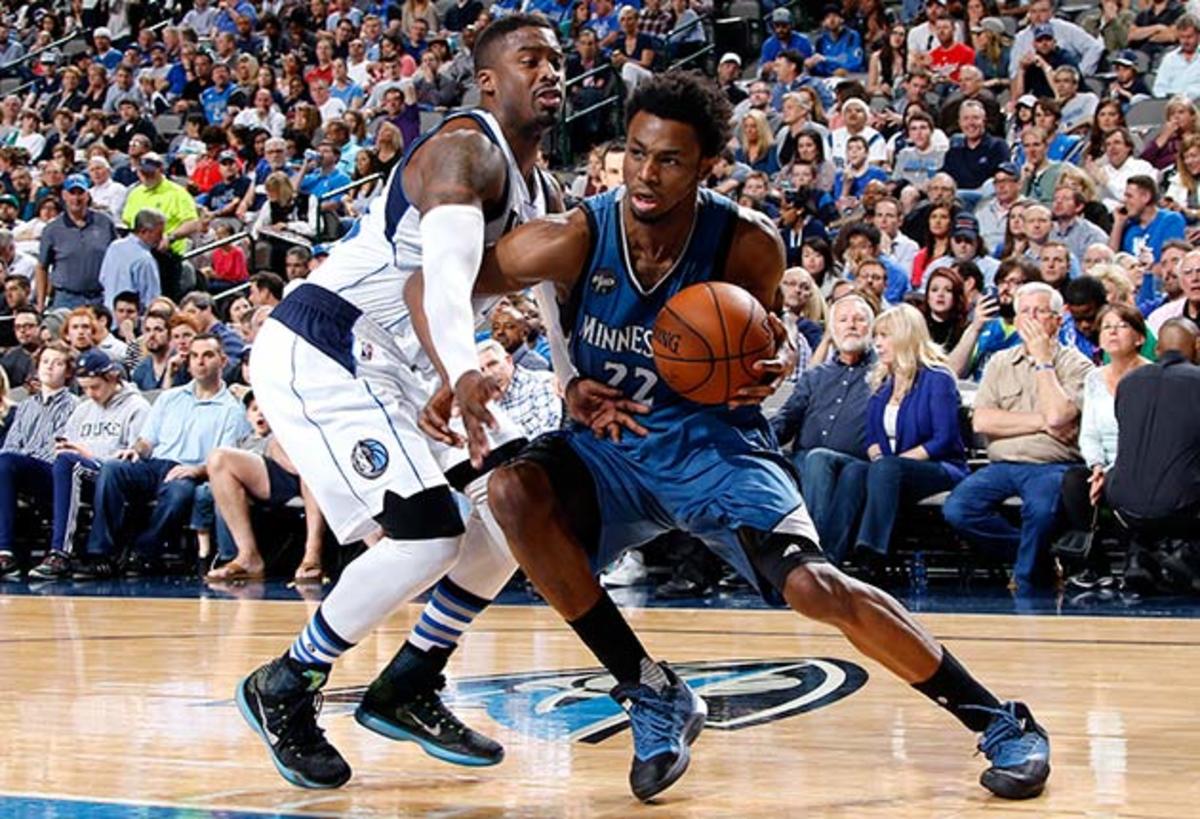
This year, Minnesota has scaled back those post–ups for the sake of more perimeter work. The pick–and–roll is a fixture in Wiggins’s life in a way it never had been previously. A variety of scripted pin–downs free him from his defender and afford the space to work on his handle. Downhill ball handling is in itself a skill, and the Wolves are intent to make Wiggins, now averaging a cool 20.7 points and getting to the line seven times per game, as comfortable as possible with the sensation of creating in space.
• MORE NBA: Meet the only man who can truly guard Steph Curry
“The game [has] definitely opened up,” Wiggins said. “When I come off a pick–and–roll, I just feel like I see everything. I feel everything's going a little slower than it did last year and I can just read everything better because I know where the help is gonna be, who's bumping the roller, who's covering the pop guy.”
Wolves coaches insist that Wiggins is a better passer than his assist numbers (2.0 per game) indicate—that, with time and seasoning, he could become a reliable facilitator in a motion–oriented offense. The game–winning pass Wiggins made against Oklahoma City, for example, is regarded within the organization as indicative rather than exceptional:
Whether or not this is ultimately true, it’s worthwhile for Minnesota to invest in Wiggins as a distributor. There’s room in the league for passers of all kinds. Wiggins, at the very least, has shown the ability to draw and kick, drop a pocket pass to the roll man, and pick out a teammate in transition. That he has the height to survey the floor and the length to slip the ball past his defender will give him options unavailable to other players.
This kind of rewiring is emblematic of the way Minnesota is trying to make the game easier on its leading scorer. Wiggins has proven over his two years in the league that he can produce on difficult attempts: turnaround fadeaways over multiple defenders, dunks in traffic, and tenacious drives through contact. Those shots made Wiggins the Rookie of the Year. The plays that will make him an All-Star—and the Wolves a winning team—are more complex in concept but simpler in execution.
*****
The Wolves are reminded of their collective youth on a regular basis. Ricky Rubio will sometimes spend half the shot clock pointing and orchestrating teammates to get in position. The young starters will build impressive leads only to clam up, resorting to ill–timed jumpers or falling into painful defensive errors. During a competitive home loss to the Warriors, Mitchell told his team they were experiencing a playoff–like atmosphere—in part because Tayshaun Prince was the only player in uniform who actually knew what that felt like. A recent road trip through Utah saw plans for a team dinner foiled because the restaurant chosen required that its patrons be 21 years old. Four Timberwolves—three of whom are starters—did not qualify.
Any team so young throughout its ranks is as much in need of cultural development as skill development. Getting up extra shots or going above and beyond the designated strength regimen can be helpful to a player’s performance. Creating an environment where those practices become the standard, however, has a broader, lasting value. The Wolves promote and stoke those trends whenever possible, optimistic that Wiggins and his teammates will set an enduring tone for the franchise.
All players on the team are required to get in 30 minutes of guided individual development before practice, with the youngest players getting their work in earliest. Most come even earlier for breakfast and will stay beyond the end of practice for weight and band work. Practice days, then, become a half-day commitment—a new expectation that breeds hard work and camaraderie.
• MORE NBA: Class In Session: Towns among NBA rookies getting schooled
“You get them to where that's all they know: Getting in the gym early, staying to a certain time,” Mitchell said. “They don't even realize we gave them a routine.”
Built into that routine is a battery of diagnostic and strength exercises that go beyond the weight room. Minnesota keeps tabs on even the most basic physical indicators as a means of informing its workouts. Some stiffness in the ankles or limitation in hip flexibility might alter the focus of a player’s strength plan. Biometric data might indicate that a player’s acceleration wanes when going to his left, that his stride angle is suboptimal, or that his physical movements are in some way inefficient. Staying on top of these things helps players on the floor for the developmental experiences that matter.
“We're building up [Wiggins’s] body structure to do a lot of manual work to make sure everything is where it needs to be,” said Arnie Kander, Minnesota’s vice president of sports performance. “It’s a little different than just a weight room. He's getting two to three lifts a week of big body parts, full-body movements, but he'll spend a lot of time with our physical therapist isolating rotator cuff strength and the things he's gonna need to make sure he can play every day and he can practice every day. It's a lot of hip rotations. It’s a lot of the smaller muscles and the stability muscles that allow the big muscles to do what they have to do.”
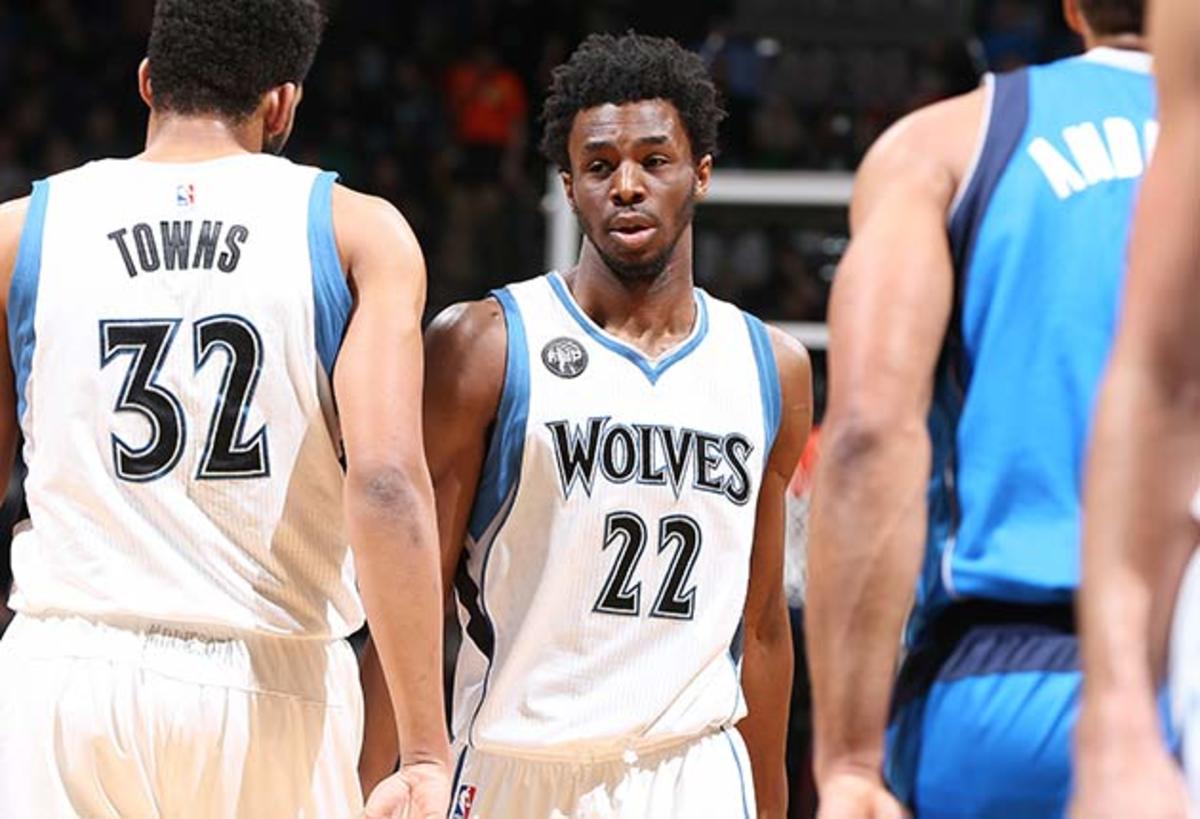
Wiggins isn’t doing conventional lifting on a daily basis at this point, though Wolves strength coach David Crewe attests that the second–year forward is keeping to his intended schedule. Most of his strength training is resistance band work. Even when slated to do more traditional lifts, Crewe often has Wiggins on custom–built equipment that swaps out a bar for a cable–tethered basketball. Minnesota doesn’t believe in strength for strength’s sake; the entirety of the Wolves’ physical training program is engineered to promote the specific and the functional.
Wiggins is still finding his place in Minnesota’s working culture. Part of being a young player is learning to work at a professional level, to bring the same concerted effort on a daily basis. Wiggins had to slowly scale up his pre–draft workouts before he was able to execute them fully. Then, as a rookie, Timberwolves coaches suspected that Wiggins—if only through the natural uncertainty of going through his first NBA season—might have held something in reserve when it came to his preparation. This season has seen his best efforts yet. Minnesota needs that of him, in part because of the way his talent lends itself to leadership.
“I always remind Andrew: These guys are going to gravitate to you,” Mitchell said. “What do you want them to be? Forget you. Andrew Wiggins has God-given talent—a little bit more than the average player. So when God sprinkled that magical dust on Andrew, a little bit more fell out the bag on Andrew than Sam Mitchell. I'll use myself as an example. So Andrew Wiggins can not work hard today and go have a great game tomorrow. But can Shabazz Muhammad do it? Can Nemanja Bjelica do it? Can Adreian Payne do it?”
Only in the NBA would a 21–year–old, himself indefinite, be held responsible for the work habits of his peers.
*****
A surprising number of coaches, executives, and players with the Timberwolves seem acutely aware of Andrew Wiggins’s three-point percentage (40%) since Feb. 1. The figure is mentioned often in conversation—once even by Wiggins himself as he smirks at Zach LaVine during a shooting drill. It is held up as a testament to hard work; Wiggins has made a committed effort to building his range for the first time in his basketball life, leading not only to improving percentages (he shot 31% last season and 25.7% prior to February) but more confident attempts.
“In my head,” Wiggins said, “I feel like I have it already. The worst thing I can do is miss it.”
Minnesota has a curious relationship to the three-pointer, held over from the coaching tenure of the late Flip Saunders. The designs of a Saunders offense tended to favor intricate, looping actions to stage post-ups and mid-range jumpers. Three-pointers were neither a fixture of the Wolves’ offense (they ranked 30th in the league last season in three-point rate) nor any kind of developmental priority. Saunders, too, had gone on–record in stating that he didn’t want the three to become a “main part” of Wiggins’s game.
Realistically, it had to become just that, and the fact that Wiggins wasn’t tracked into more consistent three-point reps from his first days with the Wolves stands as a glaring miscalculation. Better now than never. Mitchell insists his attitude towards the long ball differs from that of his predecessor, though thus far we’ve seen Minnesota’s three-point attempts inch up only slightly since moving into a more open, uptempo style after the All-Star break. A few extra attempts per game is hardly a sea change. Incremental progress, though, can be celebrated when an electric team chooses to invest in its spacing.
• MORE NBA: Inside a Warriors practice: Laughs, lessons and basketball
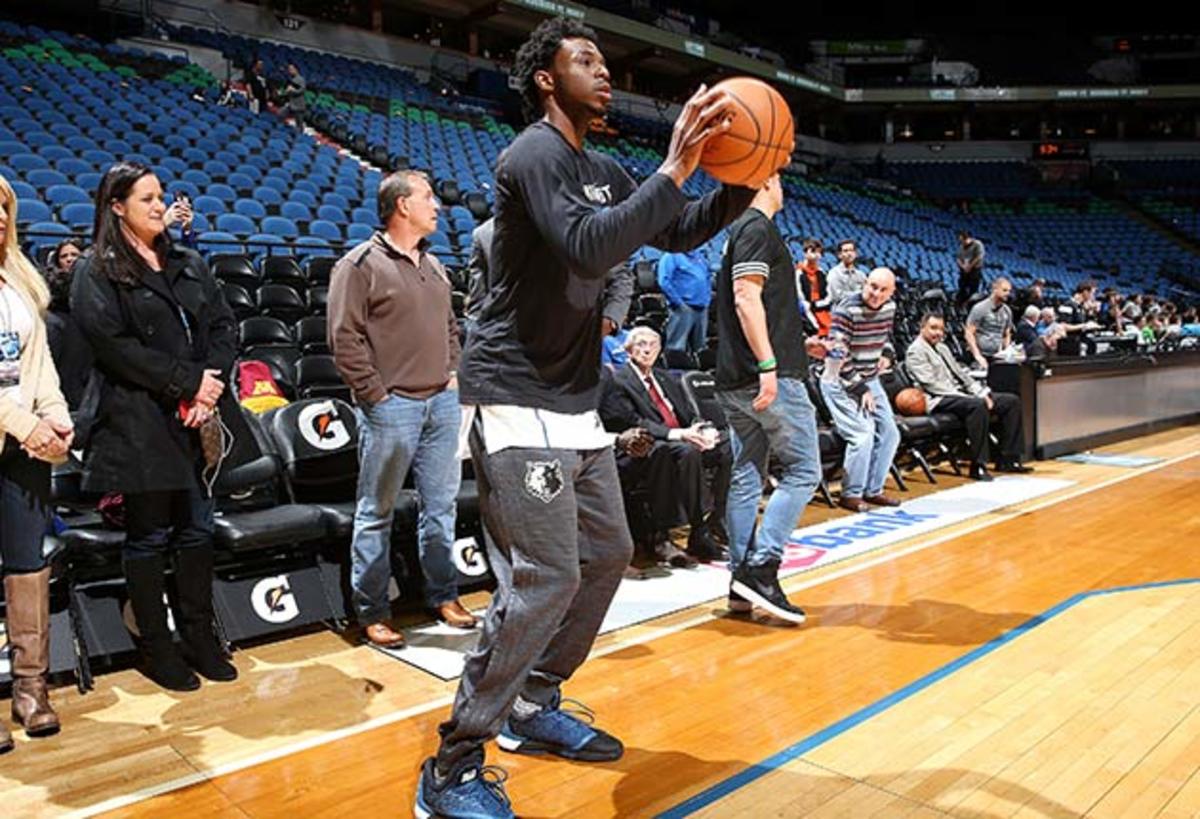
Players like Wiggins, after all, aren’t only learning to shoot. Playing off the ball without the choreography of a scripted play demands an approach all its own. There’s a nuance to getting open. The best shooters in the game are those who find room to fire despite the most obvious of intentions. Such an approach can only be built incrementally—particularly for players like Wiggins who are accustomed to operating with the ball in their hands and relatively new to the strategic exploitation of NBA defenses.
“What you also have to understand is you're also teaching spacing,” Wolves assistant coach David Adelman said. “If you tell a guy that you've gotta be in the weak–side corner if somebody attacks, well, that's what he's gonna do. He's gonna listen to you. Then you've gotta take that next step. Not everything happens at once. Now the next gradual step is exchange, read, dive. But I think the first step for us is getting those guys to understand how to help each other out by spacing the floor. Sometimes that may look like they're standing around, but I think they're just going through the gradual process of learning what the NBA game is.”
*****
During any given Timberwolves game, Sam Mitchell can be seen—and even with the distance of a television broadcast, often heard—yelling at Towns or LaVine over some particular mistake. There are many, as tends to be the case with all young players. Yet Mitchell and his staff have struck an entirely different tone in their corrections of Wiggins—effectively meeting the star pupil at his more mellow emotional center.
“You're wasting your time if you yell and curse and scream at him,” Mitchell said. “You're just wasting your time. I've learned in dealing with Andrew: I talk to Andrew. If it's something I really think he needs to do that he's not doing, I may get on him a little bit. Then if I see he's not responding to that, I just kind of grab him and we'll kind of walk around the corner and I'll talk to him.”
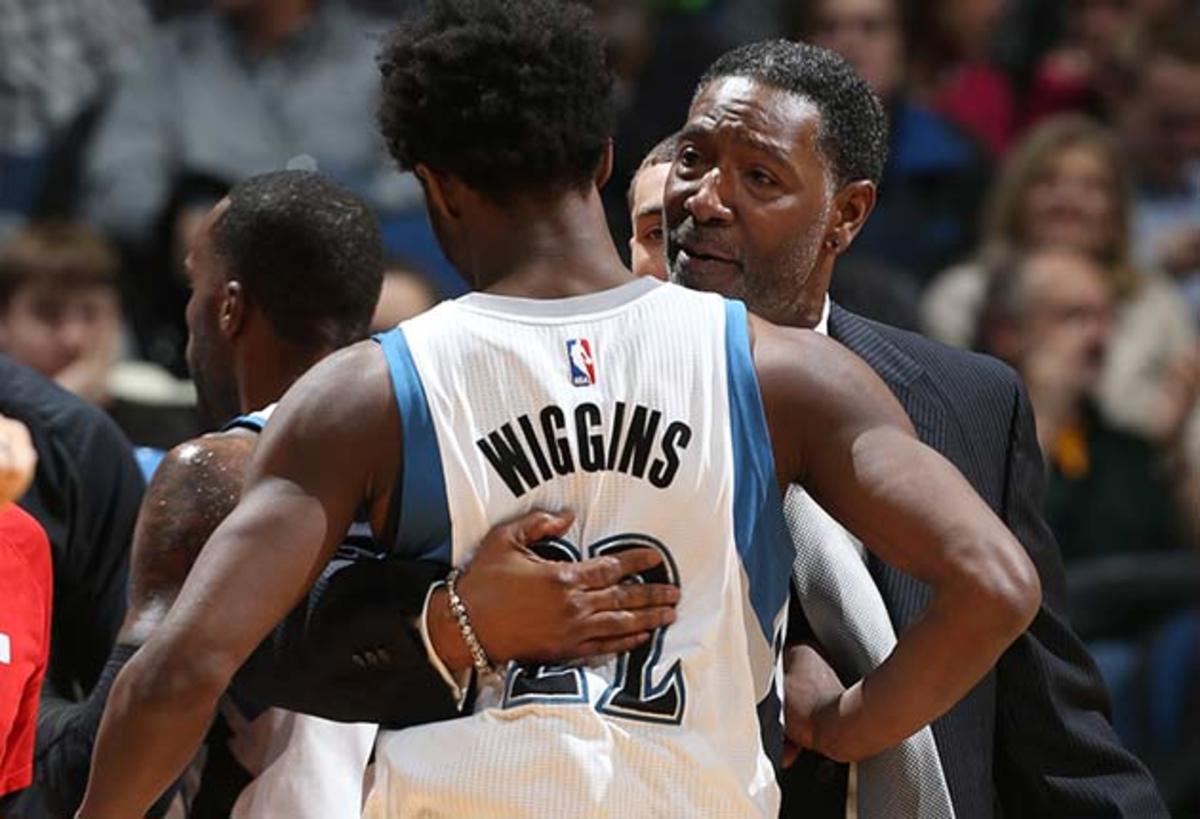
This sort of tailored coaching is critical. Even sage wisdom will fall on deaf ears if it isn’t conveyed in a way that’s compatible with a player’s learning style. In all, Wiggins comes across as an approachable, respectful student. There’s a lot to learn, though, and Wiggins is still clearly in the process of fully absorbing the basics. Only occasionally will you find him in a defensive stance, despite Mitchell’s reinforcement of that fundamental approach since training camp. Too often he’ll watch the full arc of a rebound—from carom to collection—at a standstill. The unlikeliest of opponents will beat him backdoor. Help responsibilities sometimes go entirely unfulfilled.
• MORE NBA: Blake Griffin's return: What does it mean for the Clippers?
Then, within the span of a few days, Wiggins will come across a matchup that invigorates him. Never is the vision of Wiggins’s future clearer than when lined up opposite an unquestionable star. The vacant stretches in his play—“wasted minutes,” Saunders once called them—are all but erased. It’s on those occasions that Wiggins’s focus snaps into place—as much out of pride as necessity. “It's a kill-or-be-killed league,” Wiggins said. “It's a no-mercy league. If you don't come ready to play a guy like Steph Curry or Kevin Durant, they're gonna embarrass you.”
Wolves general manager Milt Newton has largely read the way that Wiggins keys in on specific matchups as a positive—incontrovertible proof of his performance against the NBA’s finest. It’s an enviable track record for a young player. Its inverse, however, undercuts the power in Wiggins’s production and makes him a shaky defender on balance. Every player in the league knows to give their full attention to a matchup with LeBron James. What makes for winning defense is the understanding that stars, role players, and bench warmers are all deserving of a certain diligence.
“Simply put: His best games [have come] against the best players in the game,” Newton said.” That's all that we needed to see to see that when he puts it together, he will be like those top players.” The next step, per Newton, is for Wiggins to mature to the point that he’s dispatching all comers. “The 14th or 15th player—they can embarrass you as well if you're not up for them,” he said.
*****
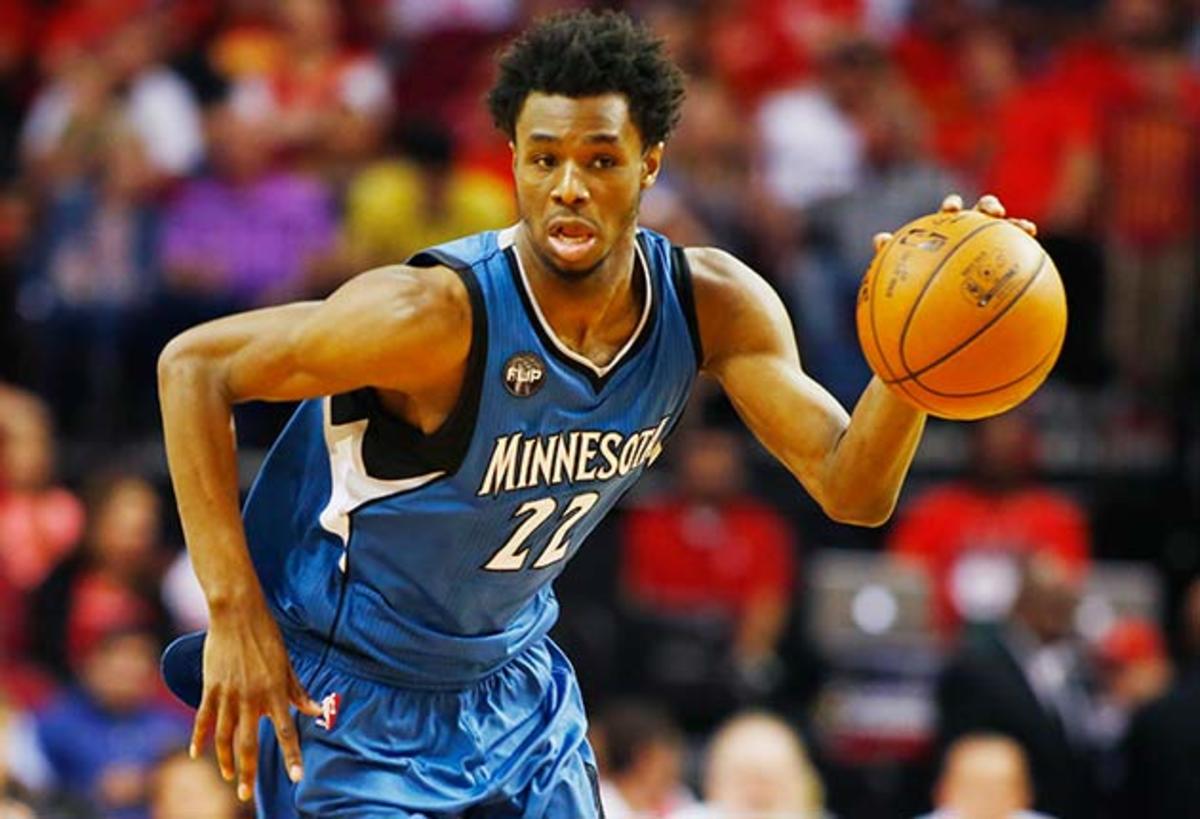
There is real momentum to the way that Wiggins and the Wolves have played of late—a spark in their budding chemistry and promise in how they’ve taken to the open floor. Yet the franchise’s greater concerns this summer supersede any trend line.
Mitchell’s future with the organization is undecided, and it’s worth considering whether his style and strategies are the best choice moving forward. Newton has been promised his post only through the summer—his first opportunity to put an imprint on the team as a primary decision-maker. Even ownership may be in flux as Glen Taylor has explored selling a stake in the franchise, completing the trinity of organizational uncertainty. The Timberwolves will have big plans for Wiggins next season. But who will design them?
Minnesota has the flexibility to transform itself, should it choose to, or use the coming years as an extension of the current administration. Wiggins will be pivotal no matter the course. The Wolves are bound to his possibility, set to swell with his progress and swoon with his struggles. Wiggins’s development is no longer his own, as his fulfillment is that of a long-suffering franchise.
